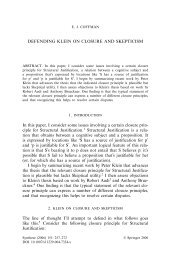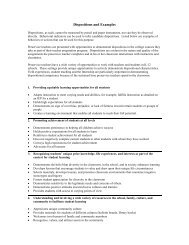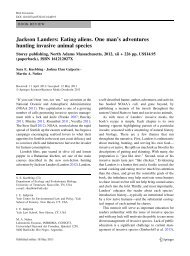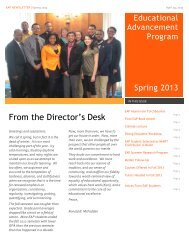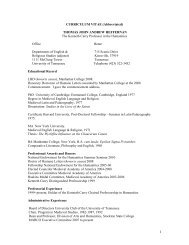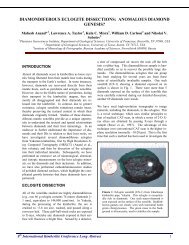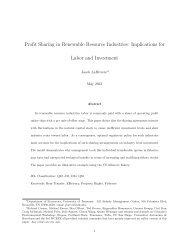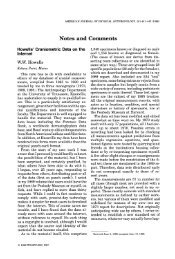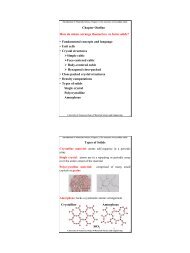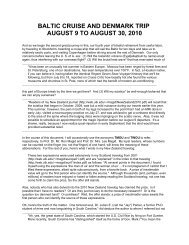Mermaids and End-Time Jezebels
Mermaids and End-Time Jezebels
Mermaids and End-Time Jezebels
You also want an ePaper? Increase the reach of your titles
YUMPU automatically turns print PDFs into web optimized ePapers that Google loves.
MERMAIDS AND END-TIME JEZEBELS:<br />
NEW TALES FROM OLD CALABAR<br />
Rosalind I. J. Hackett<br />
University of Tennessee, Knoxville<br />
Moving to Calabar, the capital of Nigeria’s Cross River State, in 1979 to take up a post as<br />
lecturer in Religious Studies at the University entailed more than a shift in my professional <strong>and</strong><br />
cultural l<strong>and</strong>scape. It meant leaving behind the great south-western city of Ibadan with its<br />
encroaching savanna to adopt a more verdant <strong>and</strong> riverine environment in the east. Walking the<br />
quaint <strong>and</strong> historical streets of Old Calabar one’s perspective was dominated by the magnificent<br />
Calabar River as it snaked its way to the Bight of Biafra some twenty-five miles to the south<br />
(FIG 1). On the other side of this small rain-soaked city was the quieter Great Kwa River,<br />
bordered by dense mangrove vegetation so clearly visible as one approached by air (FIG 2).<br />
Further to the west could be found the complex, winding Cross River after which the state was<br />
named.<br />
The move to Calabar also meant learning about a traditional pantheon which accorded a more<br />
prominent place to ndem, the mainly aquatic spirits which served as tutelary deities of the Efik<br />
people. They were prayed to for blessings, fertility, <strong>and</strong> forgiveness. I was told that they tended<br />
to possess people with lighter skins, hence the cult devotees usually wore white. I read<br />
missionary accounts which speak of albino girls being offered as sacrifices at Parrot Isl<strong>and</strong> just<br />
down the river from Calabar. Yet when I started attending local chieftaincy celebrations or royal<br />
burials (while not forgetting modern rituals such as the opening of new banks), it was the Ekpe<br />
or traditional secret society masqueraders who tended to dominate with their powerful costumes<br />
<strong>and</strong> movements. As Calabar’s fortunes shifted from fishing to trading in the 19 th century Ekpe<br />
rituals had gained ascendancy. Today, this secret society is a shadow of its former political self,<br />
functioning as the last bastion of Efik traditional culture <strong>and</strong> communal organization, its<br />
knowledge <strong>and</strong> hierarchy accessed only via costly <strong>and</strong> esoteric initiation rituals. Yet the<br />
continuing relationship of the Calabar peoples (mainly Efik, but also Ejagham <strong>and</strong> Ekoi<br />
communities) to the ubiquitous waterways for their transportation <strong>and</strong> livelihood (in the late<br />
1970s the port of Calabar was built) has ensured that the lore of the waters, <strong>and</strong> their pleasures<br />
<strong>and</strong> perils persist.<br />
I remained for four years at the University of Calabar (1979-83); <strong>and</strong> this account is based on<br />
that period of my life, together with return visits every few years up until the present time. To<br />
refer to Mami Wata in this context is to some extent an over-simplification (<strong>and</strong>, arguably, a<br />
modernization ) given the complexity of the Efik ndem pantheon in terms of numbers <strong>and</strong> gender<br />
(Hackett 1989: 28-32, 179-181). I am less interested in whether Mami Wata is a local or foreign<br />
spirit, or a (post)modern interpretation of an ancient belief (she strikes me as all of the above),<br />
but rather the links between old <strong>and</strong> new stories about water spirits in Calabar <strong>and</strong> beyond. 1<br />
These stories of spirit-human relations provide insight into the contested images of water,<br />
1
women <strong>and</strong> misfortune. 2 Addressing perennial concerns about wealth <strong>and</strong> sexuality, they find<br />
new life in the worldviews of modern-day pentecostal Christians with their elaborate <strong>and</strong> vivid<br />
spirit imaginary--that of a dualistic world inhabited by warring spiritual forces.<br />
My memory fails me as to when I first heard of Mami Wata. It was perhaps the time when a<br />
motorized canoe traveling to neighboring Creek Town overturned in one of Calabar’s torrential<br />
storms. Some survived, but of those who drowned it was said that Mami Wata had claimed<br />
another victim–luring him or her down to her watery kingdom. There was also talk of the canoe<br />
being capsized by a “sea cow” (or manatee, of which only a few remained in the area at that time<br />
according to my biologist friends). I was never very clear if this was considered to be a<br />
“manifestation” of Mami Wata but there seemed to be some link in people’s minds. 3 Then there<br />
was the case of the niece of a Ghanaian colleague who slipped away from a family picnic at the<br />
Great Kwa Falls, a local beauty spot, <strong>and</strong> disappeared mysteriously into the watery depths never<br />
to return. The much publicized accidents which occurred during the building of the new port in<br />
the late seventies <strong>and</strong> early eighties were also attributed to the displeasure of Mami Wata at the<br />
occupation of her realm. 4 The port authorities had to resort to the traditional means of sacrifice<br />
to continue with their work By this time such happenings made the local newspapers, such as<br />
the now defunct Nigerian Chronicle, conveying mixed messages of anachronism yet existential<br />
reality, as well as alterity (Battestini 1991).<br />
Closer to home, on campus, there was a student of mine whose behavior started giving cause for<br />
concern. He would w<strong>and</strong>er in <strong>and</strong> out of classrooms with a wild-eyed look. Attempts to heal his<br />
mental condition failed at both the local psychiatric hospital as well as a local spiritual church.<br />
His worsening mental condition was explained to me by the students as possession by Mami<br />
Wata. Likewise, a female student in our department, desperate, yet unable, to conceive a child,<br />
was cast in the same light. Women sometimes initiate relationships with personal water spirits in<br />
order to overcome infertility. These spirits have a reputation for jealousy <strong>and</strong> expensive tastes.<br />
They can be blamed for a variety of physical, material, <strong>and</strong> emotional problems if their dem<strong>and</strong>s<br />
are not met. Alternatively, it is believed that they may seek out a “spouse” <strong>and</strong> reward the person<br />
with worldly success but deprive them of progeny <strong>and</strong> happiness in marriage. It was only later<br />
that I read Flora Nwapa’s 1966 novel, Efuru, on this intriguing subject.<br />
Having been exposed to Mami Wata stories I now felt the need to see her images <strong>and</strong><br />
accouterments of power. An Ibibio student took me to the mainl<strong>and</strong> one weekend to visit a<br />
Mami Wata priestess. She proudly showed us her Mami Wata “telephone”–a long wire strung<br />
between two poles, on the top of one sat a boat with Mami Wata at the helm <strong>and</strong> her retinue<br />
behind. The spirit figure had long hair <strong>and</strong> a light skin. We were shown the priestess’ “spirit<br />
husb<strong>and</strong>” (a merman as opposed to mermaid). He too had light pink skin <strong>and</strong> his torso was<br />
encircled with a snake. His altar was full of white objects, such as talcum powder <strong>and</strong> a statue of<br />
the Virgin Mary. Regrettably it was several years before I came across the first scholarly<br />
accounts of Mami Wata symbolic representations <strong>and</strong> their provenance (see, eg. Salmons 1977).<br />
It was only when I returned to Calabar in 1991 <strong>and</strong> attended a chieftaincy installation where the<br />
ndem performers were resplendent (perhaps because it was a woman being installed) (FIG 3),<br />
2
that I understood the adornments <strong>and</strong> movements of the principal dancer (FIG 4). By then I had<br />
read Henry Drewal’s influential theory that images of Mami Wata in the region can be traced to<br />
an early German chromolithograph of a female Indian snake-charmer which began circulating in<br />
West <strong>and</strong> Central Africa at the turn of the century, <strong>and</strong> more extensively from the 1950s onwards<br />
(Drewal 1988). He further argues that the alien, exotic objects (such as talcum powder, Virgin<br />
Mary statues, sunglasses, etc.) which often form part of the shrine complexes of Mami Wata<br />
worshipers are used by the people to define themselves <strong>and</strong> address problems of self-identity<br />
(Drewal 1996) (cf. Wendl 1990). I also liked Margaret Thompson Drewal’s argument that the<br />
snake-charmer image proved popular as many local artists saw it as Mami Wata’s “photograph”<br />
(Drewal 1990:42f.).<br />
I once, myself, tried unsuccessfully to take Mami Wata’s photograph. It was in fact a place<br />
associated with the local spirit. We were returning from a trip out of Calabar with some Ibibio<br />
friends <strong>and</strong> they casually pointed out this small cabin, modern in appearance, sitting back from<br />
the highway on cleared l<strong>and</strong>. They indicated, with some amusement, that it was a “house” built<br />
for Mami Wata <strong>and</strong> that no-one lived in it. I asked if I could stop <strong>and</strong> photograph it. They<br />
cooperated <strong>and</strong> I went home in the belief that I had captured this special dwelling on film. When<br />
the film was eventually developed some weeks later, the images that I most wanted to see were<br />
simply not there! This strange occurrence did not surprise my friends, however Presbyterian<br />
they were. I do, however, retain an image of that “dwelling” in my mind’s eye.<br />
Stories such as those alluded to above concerning particular types of misfortune, namely<br />
mysterious drownings, infertility, <strong>and</strong> mental disorder <strong>and</strong> their attribution to the activities of<br />
Mami Wata might have been expected to decline with the substantial growth of Christianity in<br />
Calabar since the first missionaries arrived in 1846. Naturally people have negotiated, either as<br />
individuals or as congregations, which aspects of their “traditional heritage” they wish to retain,<br />
amend or reject. On the whole, the mainline, mission-related churches (e.g. the Presbyterian,<br />
Anglican, Methodist, <strong>and</strong> Roman Catholic churches) have been more forgiving <strong>and</strong><br />
accommodating of local, indigenous practices than have the newer evangelical <strong>and</strong> pentecostal<br />
movements which began to take off in Calabar in the mid-1980s (Hackett 1989: 197f.). They are<br />
characterized by an emphasis on individual salvation, conservative piety, <strong>and</strong> an exclusivist<br />
approach to other churches which they do not consider to have “Bible-believing” foundations.<br />
The pentecostal churches <strong>and</strong> ministries accord a greater place to the works of the Holy Spirit,<br />
<strong>and</strong> by extension, to negative spiritual forces whether conceived in the form of Satan, witchcraft,<br />
ancestral, aquatic, or nature spirits. 5 They have developed specific deliverance ministries,<br />
through publications, audio cassettes, <strong>and</strong> special healing services as an extension of their often<br />
elaborate demonologies. 6 It is their concern with the mermaid or “marine” spirits that is apposite<br />
here.<br />
When I returned to Calabar in the summer of 2001, <strong>and</strong> enquired about the current status of<br />
Mami Wata beliefs, I was told by my well-connected Efik women friends that most of their<br />
acquaintances considered Mami Wata to be a thing of the past, except if they belonged to one of<br />
the newer pentecostal churches. Naturally their answer intrigued me <strong>and</strong> I requested further<br />
explanation. 7 They claimed that the newer churches are perpetuating, if not reviving, beliefs in<br />
3
aquatic spirits as sources of people’s problems, <strong>and</strong> that the appropriate spiritual remedies must<br />
be sought. These churches also make people change their names (to Blessing, Grace, Andy, etc.)<br />
if they have mermaid spirit connotations, such as Ekanem, Ndem, Andem, Ekpenyon, Efiok,<br />
Bassey, <strong>and</strong> Oku. Parents with “witchcraft” or “satanic” connections are blamed for giving their<br />
offspring such names.<br />
I did not have the time to check out one of these Calabar pentecostal churches but a few days<br />
later in Lagos I was able to attend one of the fastest growing pentecostal or deliverance<br />
ministries known as Mountain of Fire <strong>and</strong> Miracles. It nestles behind the back gate of the<br />
University of Lagos in Akoka, <strong>and</strong> has no visible structures from the road. Yet somehow, a<br />
hundred thous<strong>and</strong> people cram into the various halls, alleyways <strong>and</strong> rooms that form their rabbit<br />
warren-like compound. The founder <strong>and</strong> General Overseer of the movement, Dr. D.K. Olukoya-<br />
-a British-trained micro-biologist--has a prolific output of magazines <strong>and</strong> books. My eyes<br />
alighted upon one publication in particular, Fire in the Word, with its theme for the week,<br />
“Disgracing Marine Spirits.” 8 (FIG 5) It contains a five-page transcription of a message<br />
delivered by Dr. Olukoya at a previous service. It first identifies biblical references which<br />
(could) refer to marine spirits, <strong>and</strong> their “half fish, half human” form, then addresses the<br />
problems that beset those who get involved with women or men “from the water,” namely<br />
promiscuity <strong>and</strong> polygamy, as well as anger <strong>and</strong> frequent dreams about water. Olukoya insists<br />
that this type of spirit is one of the most potent <strong>and</strong> dangerous, yet often ignored as people more<br />
readily attribute their “lack of success” to “earth spirits.” Marine spirits operate by seducing<br />
people through fine clothes (notably “wet look” dresses), food, jewelry, dancing <strong>and</strong> music (FIG<br />
6). Such spirits are also found in hairdressing salons (the spirits purportedly favor particular<br />
styles such as braids) <strong>and</strong> Chinese restaurants (because of the marine symbol frequently<br />
advertizing the latter). 9 One can also be “polluted” by one’s parents if they worshiped Yemoja,<br />
Olokun, or other types of water spirit. Churches that are situated near the river or beach <strong>and</strong> that<br />
baptize their members in water which is not clear to the bottom are also suspected of having<br />
links with such spirits. So too are those who visit streams or rivers for “cultural reasons.” 10<br />
Furthermore, Olukoya claims that marine spirits try to control the economy (as most goods pass<br />
through the sea), <strong>and</strong> are responsible for the production of cosmetics <strong>and</strong> alcohol. Interestingly,<br />
he also attributes the environmental desolation in the riverine areas of Nigeria to these demonic<br />
powers (rather than to oil companies), as well as to “sexual looseness” whether in the form of<br />
adultery, pornography, lesbianism, incest or abortion. 11 Dr. Olukoya proposes various spiritual<br />
strategies for defeating these water spirits, such as declaring “holy war” on them <strong>and</strong> spreading a<br />
“prayer net” to trap them 12 . As one can see from the cover of the newsletter, two devilish<br />
mermaids (one is portrayed as a witch <strong>and</strong> the other a prostitute) <strong>and</strong> two fierce-looking mermen<br />
are being roasted alive by a ring of fire. Olukoya’s ministry is, incidentally, renowned for its<br />
violent <strong>and</strong> aggressive spirituality (see Hackett 2003). 13<br />
Beliefs have long been common about the proximity of women to the spirit world, <strong>and</strong> hence<br />
their vulnerability (especially when pregnant). Similarly, social problems <strong>and</strong> moral dislocation<br />
have been readily attributed to women’s independence <strong>and</strong> excessive embrace of modern forms<br />
of dress <strong>and</strong> behavior. But the framing of these fears in the form described above raises two<br />
4
interesting questions. First, the fact that these “marine agents” are now able to penetrate the<br />
hallowed <strong>and</strong> presumed safe territory of the pentecostal church generates new fears <strong>and</strong> new<br />
quests for protection. As I was told in hushed tones by one deliverance specialist, so<br />
sophisticated are some of these newer “manifestations” of Mami Wata as virtuous church<br />
virgins, that they can manipulate through their charismatic charms not just the bodies but also the<br />
minds of men. He added that this type of spirit is the most dangerous <strong>and</strong> deceitful, <strong>and</strong> attacks<br />
pastors only. 14 Second, the maintenance, if not resurgence, of Mami Wata beliefs in these new<br />
religious contexts may be linked to millennialist claims that the increase in the number of<br />
“<strong>Jezebels</strong>” inviting the people of God to compromise with the world is “part of the operations of<br />
Satan <strong>and</strong> his demons in these last days.” 15<br />
To summarize: just as images <strong>and</strong> ideas about Mami Wata took on new form <strong>and</strong> life in contact<br />
with European commercial <strong>and</strong> colonial power <strong>and</strong> Hindu images, so too have the burgeoning<br />
pentecostal deliverance ministries provided new outlets for the recasting of traditional ideas<br />
about spirit possession by seductive <strong>and</strong> consumptive water spirits in a modern, Christian<br />
guise. 16 Further research is required on this interesting transposition in a variety of contexts to<br />
ascertain if it represents a more general trend. In the meantime, African theologians search for<br />
ways to counter this strong trend in pentecostalism to externalize rather than internalize evil. 17<br />
BIBLIOGRAPHY<br />
Bastian, Misty. 1997. Married in the Water: Spirit Kin <strong>and</strong> Other Afflictions of Modernity in<br />
Southeastern Nigeria. Journal of Religion in Africa 27 (2):116-134.<br />
Battestini, Simon P. X. 1991. Reading Signs of Identity <strong>and</strong> Alterity: History, Semiotics <strong>and</strong> a<br />
Nigerian Case. African Studies Review 34 (1):99-116.<br />
Drewal, Henry John. 1988. <strong>Mermaids</strong>, Mirrors, <strong>and</strong> Snake Charmers: Igbo Mami Wata Shrines.<br />
African Arts 21 (2):38-45, 96.<br />
Drewal, Henry John. 1996. Mami Wata Shrines: Exotica <strong>and</strong> the Construction of Self. In African<br />
Material Culture, edited by M. J. Arnoldi, C. Geary <strong>and</strong> K. Hardin. Bloomington, IN:<br />
Indiana University Press.<br />
Drewal, Margaret Thompson. 1990. Portraiture <strong>and</strong> the Construction of Reality in Yorubal<strong>and</strong><br />
<strong>and</strong> Beyond. African Arts 32 (3):40-49, 101.<br />
Gore, Charles, <strong>and</strong> Joseph Nevadomsky. 1997. Practice <strong>and</strong> Agency in Mammy Wata Worship<br />
in Southern Nigeria. African Arts 30 (2).<br />
Hackett, Rosalind I. J. 1989. Religion in Calabar: the Religious Life <strong>and</strong> History of a Nigerian<br />
Town. The Hague <strong>and</strong> New York: Mouton de Gruyter.<br />
Hackett, Rosalind I. J. 2003. Is Satan Local or Global? Reflections on a Nigerian Deliverance<br />
Ministry. In Pentecostalism <strong>and</strong> Globalisation, edited by A. Adogame <strong>and</strong> U. Berner.<br />
Bayreuth: Bayreuth University.<br />
Jewsiewicki, Bogumil. 1995. Cheri Samba: The Hybridity of Art/L'Hybridite d'un Art. Quebec:<br />
Galerie Amrad.<br />
Meyer, Birgit. 1999. Translating the Devil: Religion <strong>and</strong> Modernity among the Ewe in Ghana.<br />
Edinburgh: Edinburgh University Press.<br />
Ogrizek, Michel. 1981-82. Mami Wata, Les Envoûtées de la Sirène: Psychothérapie collective de<br />
5
l'hystérie en pays Batsangui au Congo, suivie d'un voyage mythologique en Centrafrique.<br />
Cahiers O.R.S.T.O.M. série Sciences Humaines 18 (4):433-443.<br />
Olukoya, D. K. 1999. Power Against Marine Spirits. Lagos: The Battle Cry Christian Ministries.<br />
Salmons, Jill. 1977. Mammy Wata. African Arts 10 (3):8-15.<br />
Wendl, Tobias. 1990. Miami Wata: Oder Ein Kult Zwischen Den Kulturen. Munich: München<br />
Lit Verlag, Kulturanthropologische Studien Bd 19.<br />
NOTES<br />
1.Sabine Jell-Bahlsen is particularly critical of the exoticization of Mami Wata by Western<br />
academics. See, e.g. her review of the children’s book, Mommi Watta: Spirit of the River (by<br />
Virginia Castelman, 1995) on H-AfrLitCine May 1998, “Magic from an African River: Is<br />
Education Only a Dream for Girls in Africa?”<br />
2.An excellent comparative study in this regard would be Bogumil Jewsiewicki’s analysis of the<br />
Zairean popular painter, Chéri Samba (Jewsiewicki 1995). Samba’s paintings explore <strong>and</strong> deride<br />
post-colonial Zairean urban society <strong>and</strong> its moral decay <strong>and</strong> political corruption. His depictions<br />
of prostitutes <strong>and</strong> mermaids symbolize “the story of the new power of the Independence of<br />
which the people were robbed” (p. 94). The white man, with his predilection for young Zairean<br />
women, signifies both moral <strong>and</strong> political evil. According to Jewsiewicki, he is “the equivalent<br />
of a male mami wata” (p. 96).<br />
3.Allen Roberts notes that he came across stories of manatee <strong>and</strong> Mami Wata connections in the<br />
inl<strong>and</strong> lakes while working in Chad in the 1960s. Communication on H-AFARTS, 17 April<br />
2001. See also the “revelation” by Ghanian scientists at the Institute of Aquatic Biology of the<br />
Centre for Scientific <strong>and</strong> Industrial Research <strong>and</strong> the Wildlife Department that “the sea goddess<br />
reputed to be a source of absolute beauty <strong>and</strong> money could be the West African Manatee, an<br />
aquatic, herbivorous animal” (“Ghanian Scientists Unravel Mystery Mermaid’s Being,”<br />
Panafrican News Agency, 5 April 2001).<br />
4.Accidents at road bridges were also given this “sacrificial” interpretation as they were<br />
commonly attributed to the displeasure of water spirits.<br />
5.Birgit Meyer’s work, Translating the Devil, is the most thorough study of pentecostal<br />
demonology in an African context (Meyer 1999). Focused on Ewe pentecostal churches in<br />
eastern Ghana, her insightful analysis both historicizes images of the Devil <strong>and</strong> people’s<br />
obsession with occult forces, <strong>and</strong> links these beliefs to their ambivalent attitudes to modernity.<br />
The centrality of “Satan’s most erotic demon” <strong>and</strong> “most seductive agent” in the popular<br />
imagination of urban Accra (notably films <strong>and</strong> video-movies) points to the fantasies <strong>and</strong> fears<br />
associated with a modern way of life <strong>and</strong> “its global entanglements” (Meyer, this volume).<br />
6.It is important to note that these movements are commonly sub-divided according to the<br />
orientation of the movement, i.e. deliverance, holiness, righteousness, prosperity, <strong>and</strong> “slain in<br />
the Spirit” ministries. Rev. Dr. Andrew T. Gb<strong>and</strong>eh-Mitta, personal communication, 14 August<br />
2001.<br />
6
7.I had actually raised the possibility of continuity between traditional ideas of mermaids <strong>and</strong><br />
pentecostal fears of “marine agents” posing as virtuous, virginal choristers at a panel that I<br />
organized at the 1995 African Studies Association annual meeting in Orl<strong>and</strong>o, entitled “Mami<br />
Wata: New Perspectives <strong>and</strong> Peregrinations” but did not pursue it at the time for lack of written<br />
data.<br />
8.Sunday 22 - Saturday 28 April 2001.<br />
9.Starbucks, with its (even more explicit) mermaid logo, has not yet reached Nigeria.<br />
10.Greater detail on the operations of these spirits <strong>and</strong> their provenance can be found in<br />
(Olukoya 1999).<br />
11.Strange sexual dreams <strong>and</strong> behavior are still commonly attributed by adolescents, notably in<br />
boarding school environments, to Mami Wata. Manza A. Agovi, personal communication, 15<br />
November 2001. (Cf. Ogrizek 1981-82 for a French doctor’s psychoanalytical analysis of<br />
female hysteria, Mami Wata beliefs <strong>and</strong> communal healing in Congo <strong>and</strong> the Central African<br />
Republic).<br />
12.Evangelist Victoria Eko’s widely read Exposition on Water Spirits recommends a “heavy<br />
dose of the scriptures” to keep the perils of these demonic spirits at bay (p. 57).<br />
13.They have a useful website: www.mountain-of-fire.com.<br />
14.Rev. Dr. Andrew T. Gb<strong>and</strong>eh-Mitta, personal communication, 14 August 2001. He is from<br />
Sierra Leone but lived in Lagos for ten years.<br />
15.Interestingly, these are the words not of a man, but Lady Evangelist Bimpe Adekeye in the<br />
section, “Stumbling Blocks in Women Ministry [sic]” of her publication, Sisters in the <strong>End</strong> <strong>Time</strong><br />
Army (Ibadan, n.d.) p.33. This publication was made available to me by Dr. Bolaji Bateye,<br />
whose research on women in the spiritual <strong>and</strong> pentecostal churches confirmed this phenomenon<br />
more widely. Personal communication, 21 July 2001. In light of the first question, the <strong>Jezebels</strong><br />
that Adekeye is referring to are not the more obvious “street women” but “modern-day women<br />
preachers who go about with their bodies painted, putting on transparent, tight <strong>and</strong> short dresses,<br />
<strong>and</strong> with the kind of hairdos that look like that of harlots to seduce God’s people to sin <strong>and</strong><br />
commit adultery in their hearts” (ibid.).<br />
16.Gore <strong>and</strong> Nevadomsky focus more on the reception rather than the production of Mami Wata<br />
ideas <strong>and</strong> images, leading them to assert that there is more local agency <strong>and</strong> discontinuities in<br />
representation than Drewal’s analysis shows (Gore <strong>and</strong> Nevadomsky 1997). Certainly, their<br />
approach is more illuminating of the integration of Mami Wata beliefs <strong>and</strong> practices into presentday<br />
Christian communities. The research <strong>and</strong> video documentation by Kofi Asare Opoku <strong>and</strong><br />
Kathleen O’Brien Wicker on a eastern Ghanaian Mami Wata shrine (“Priesthood <strong>and</strong> Ritual in<br />
Ghana”) also confirms this interpretation. Misty Bastian’s anthropological analysis of spiritualhuman<br />
relationships as a commentary on kinship <strong>and</strong> alliance, <strong>and</strong> modern urban problems in<br />
7
Nigeria, proves even more fruitful (Bastian 1997). Based on her research on divination in Sierra<br />
Leone, Rosalind Shaw emphasizes the importance of secrecy with regard to the capacities<br />
Temne women obtain from river spirits. Women are perceived by men as unknowable given<br />
their exogenous origins <strong>and</strong> they are likened to rivers (this volume).<br />
17.See, for example, the special issue of Journal of African Christian Thought, 4,1 (June 2001)<br />
on “Gospel <strong>and</strong> Culture: Issues of Engagement.”<br />
8



